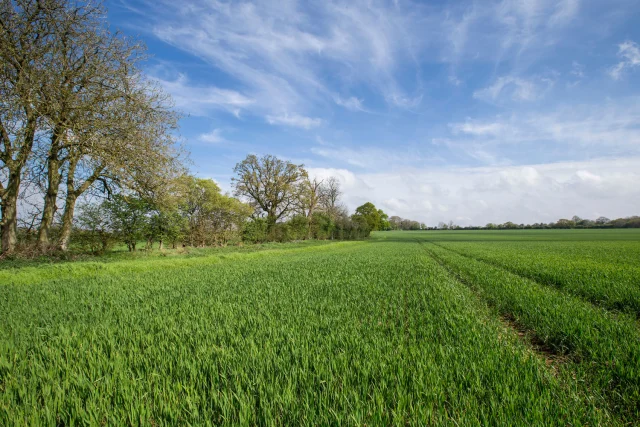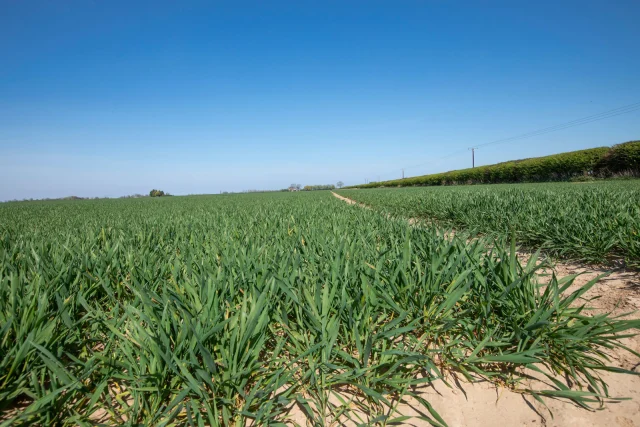Published on 1st March 2022
Local Insights
Six top agronomy tips for crops in Scotland this March

Get the latest insight and expert advice for your farm, Grant Reid suggests six areas for arable growers to concentrate on this March in Scotland.
Six top agronomy tips for crops in Scotland this March Content
Crop Progress
The kind autumn and winter backend weather, helped by crops taking up any leftover nitrogen in the soil from the 2020/21 season, has led to well-established crops. There are very few, if any, fields that will need ripping up. The February wet weather means, as this is written, there are a few wet holes, but because they generally have good root systems, should mean they will be okay, even if they do lie in water unless it is for weeks on end.
Some wheat and barley crops are quite forward, which has led to a few growers grazing these with sheep, which seems to be working well. Oilseed rape crops that were grazed earlier seem to be recovering well.
Oilseed rape was getting “pigeoned” in February, so hopefully you had the bangers / piegon scaring tactics working effectively. Still on the forward crops, you could argue a bit of pigeon damage won’t do too much harm. Generally the crops look good, and given the price currently it will make sense to look after the crop as much as possible.
The main disease in wheat seems to be Septoria. We haven’t had too many frosts so far, although at the time of writing there’s still for winter yet.
Grant’s agronomy tips for March
1. Monitor fields for spring weed control
Most crops were sprayed with either pre-emergence and / or early post-emergence herbicides in the autumn, which have worked well, so fields generally are looking clean from weeds.
Fields will still need monitoring for spring germinating weeds, particularly bromes, as weather becomes milder. Identify where you have issues, and if there is good steady spell of milder weather and signs of active growth, you might want to consider applying Pacifica Plus (mesosulfuron + iodosulfuron + amidosulfuron), for example, in March.
It is a fine balance on deciding when to apply – efficacy tends to be better against smaller weeds, but equally conditions for application needs to be favourable. If it’s still on the cooler side you might be better waiting for warmer weather in April.
Last year in our weed screen close to Edinburgh we had much better control from April applications than in March, partly because there were a lot of frosts in March. But in other years we’ve also seen March applications work better than April ones, so it does vary year on year.
2. Manage forward winter barley crops
With a lot of forward winter barley crops, growth regulation and trace element, especially manganese, applications are likely to be the highest priority for Scottish growers in March, assuming the weather plays ball.
In lush forward crops look out for mildew and Rhynchosporium in crops too, along with potentially net blotch and brown rust. First T0 applications for these diseases could be towards the end of March.
While Proline (prothioconazole) could be an option at this timing – it covers all those diseases – my inclination would be to save its use until the main timings. Cyprodinil-based products are a decent alternative.
3. Start considering whether you need a T0 in wheat crops
Similarly to winter barley, depending on weather, if you’re planning to spray a T0 fungicide that could be at the end of the month, or into early April.
There is some Septoria in winter wheat. As we approach the end of February, I’m not aware of any yellow rust, but the risk will increase as we go through March. Tebuconazole is likely to be a popular choice for T0 sprays to cover yellow rust, while either a formulated product or tank mix partner with mildew activity will be an added bonus.
Again, I’d avoid straight prothioconazole at this timing – a co-form with tebuconazole makes more sense – but I’d save prothioconazole for the main timings.
As with winter barley there’s likely to be a need for growth regulation during March, if you haven’t had sheep grazing.
4. Consider using new CropCheck service to assess disease risks
Expanding on our Rapid Disease Detection service from last season, this season’s CropCheck service includes testing for latent infections of Septoria and yellow rust in winter wheat, Rhynchosporium and net blotch in winter barley, as well as light leaf spot and other diseases in oilseed rape.
The CropCheck service in wheat and barley uses PCR analysis of the leaf to assess whether a disease is present in the leaf before it is showing symptoms giving extra information to help you understand risk in your crops.
It’s important that it’s not used as the only part of your decision-making process though – it is only a snapshot in time and all the other factors you would normally use to help with decision-making, such as variety choice, weather, drilling date, etc., are equally, if not more important.
To register your interest in CropCheck click here.
5. Keep light leaf spot from rising up oilseed rape plants
Light leaf spot has been starting to show up more since Christmas. Use our SpotCheck service to check your crops for disease.
Depending on what that shows, the variety’s resistance rating and when you last sprayed, I would suggest thinking about getting some protection on the plant while it is at welly boot height and before stem extension, if possible.
If light leaf spot is in the crop you don’t want it getting up onto the flowers and into the pods. Proline (prothioconazole) is a good option, although check the label to make sure you don’t or won’t exceed the maximum total dose for the season.
You could also think about a growth regulator at this timing – perhaps a prothioconaozle + tebuconazole co-formulation – but plenty of growers don’t use one and seem to get on fine.
6. Prepare for potato planting
Our one remaining granular nematicide left in the armoury, nemathorin has regulatory approval until April 2025, but as the quick withdrawal of Vydate showed, it doesn’t necessarily mean it is safe until then, so we need to start preparing
Most land – certainly for seed potatoes – will have already been sampled for potato cyst nematode levels, but it is well worth doing as part of the preparation for potato crops. Other cultural controls to consider, especially where PCN pressure is higher, include growing varieties with good resistance to the pest, albeit with the caveat that varietal choice is dictated by end markets and as such choices might be limited.
If you are faced with land with high counts also consider whether growing potatoes on those fields is actually the right decision, or whether growing a biofumigant crop for a longer period could help make potato land more viable.
With the uncertain long term future over nemathorin it would also be sensible to consider trying out our liquid nematicide Velum Prime (fluopyram) to see how you get on with it. It’s not a silver bullet, offering suppression rather than full control of PCN, but it is another tool to consider alongside cultural controls.
In low pressure situations it can be used alone, while in medium to high pressure scenarios it can be used in combination with half rate nemathorin. One key benefit of Velum Prime is its extremely low use rate, which makes it easier to use and store. Application can either as an in-furrow application or an overall spray with incorporation. Our “Velum Prime for Potatoes” leaflet provides more information.



